Insect and Related Pests of Foliage Plants
Mealybug Species and Photos
Learn more below about common mealybugs.
-
Longtail Mealybug
This is the longtailed mealybug, pesudococcus longispinus (Targioni-Tozzetti). Notice the long waxy filaments around the body, the long tails and the absence of stripes on the body. This species doesn't prodice an egg mass or ovisac.
- One stripe in the middle of back
- Fringe Present with thin filaments around body
- Body fluid light clear
- Egg sac none
- Anal filaments present with one pair longer than the body and a second pair that are long but not as long as the first pair
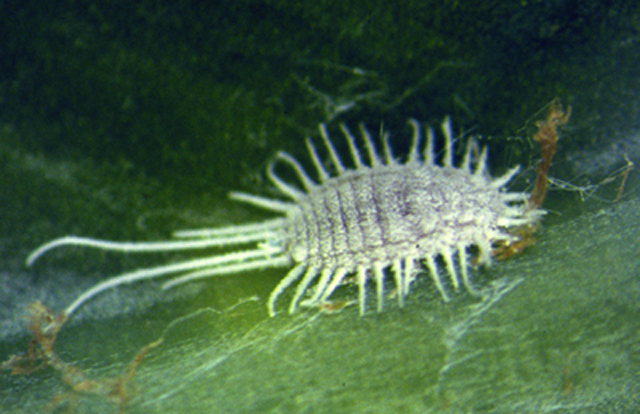
-
Citrus Mealybug
This is the Citrus mealybug, Planococcus citri (Risso). Notice the medium-sized waxy filaments around the body, absence of long tails and the single dark stripe down the center of the body. This species produces an egg mas or ovisac.
- One stripe in the middle of the back
- Fringe short, slightly curved filaments around body
- Body fluid clear
- Ovisac irregular and under body of female
- Anal filaments less than one-eighth of the body
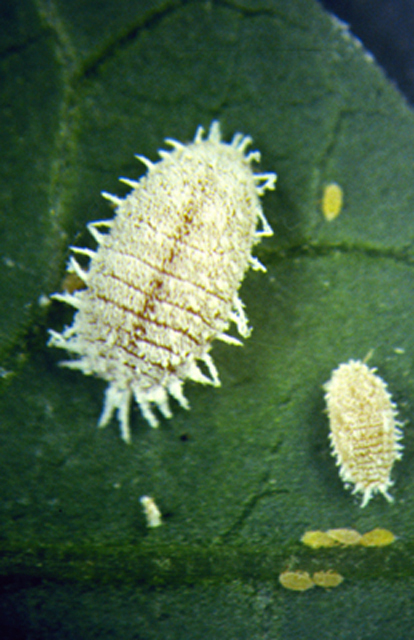
Female citrus mealybug.
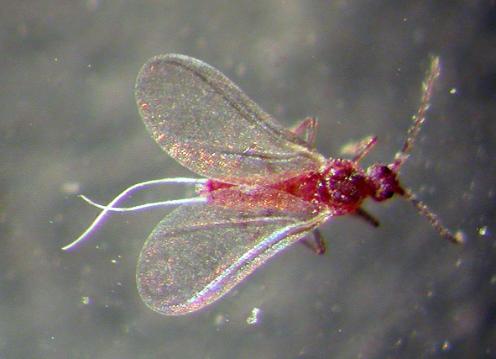
Male citrus mealybug.
-
Madeira Mealybug
Phenacoccus madeirensis Green (Madeira mealybug) is a mealybug that has become important during the last couple years. It has a wide host range. Notice the short waxy filaments around the body, absence of long tails and the absence of a single dark stripe down the center of the body. This species produces an egg mass or ovisac.
Phenacoccus gossypii & P. madeirensis
- Two dark stripes on back
- Fringe present, short filaments around body
- Body fluid pale greenish
- Ovisac very regular covering body except head
- Anal filaments about one-fourth the length of the body
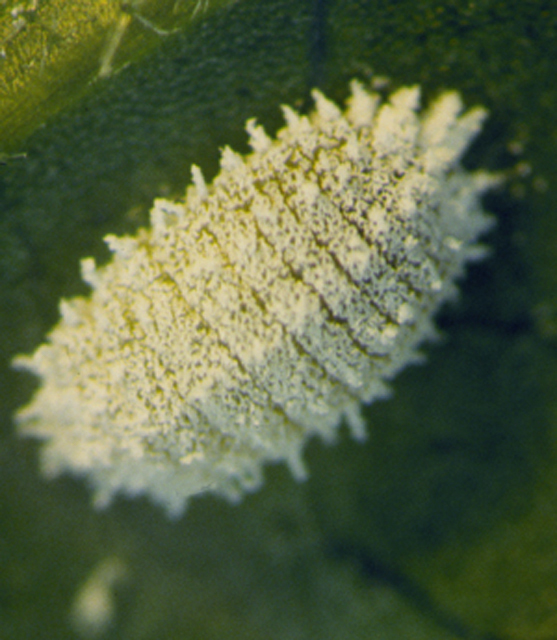
-
Solanum Mealybug
This is the Solanum mealybug, Phenacoccus solani ferris. Notice the very short waxy filaments around the body, the absence of long tails and the absence of stripes on the body. This species doesn't produces an egg mass or ovisac.
- Fringe present, short filaments around body
- No ovisac produced
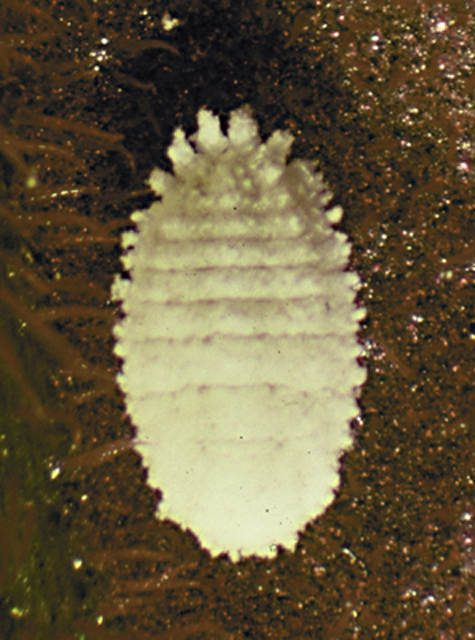
-
Striped Mealybug
This is the Striped mealybug, Ferrisia virgata (Cockerell). Notice the very long waxy filaments around the body, the long tails and the presence of two stripes on the body. This species does produce an egg mass or ovisac.
- Fringe heavy and wedge-shaped
- Two dark stripes on the back
- Body fluid light color
- No ovisac produced
- Anal filaments present and about one-half the length of the body
- Long glassy rods on back

-
Solenopsis Mealybug
This is the Solenopsis mealybug, Phenacoccus solenopsis Tinsley. Notice the short to medium sized waxy filaments around the body, absence of long tails and the two dark stripes on either side of the middle “ridge” of the body. This species produces an egg mass or ovisac.
- Short filaments around body
- Two dark stripes on the back
- Anal filaments about one-fourth the length of the body
- Long glassy rods on back

-
Papaya Mealybug
This is the Papaya mealybug, Paracoccus marginatus Willams. Notice the lack of waxy filaments around the body, absence of long tails and no obvious stripes. This species produces an egg mass or ovisac.
- No short filaments around body
- Yellow to light green body and eggs
- Body covered with a light "dusting" of wax
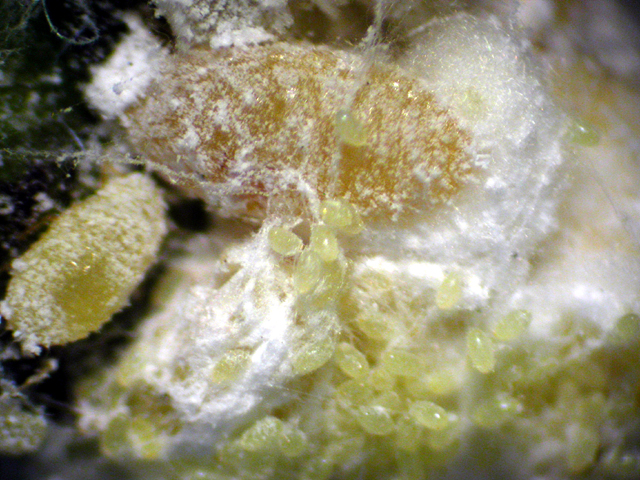
-
Hypogeococcus pungens
This is Hypogeococcus pungens (Granara de Willink). This species is one that may be confused for the Pink hibiscus mealybug. The body is pink to red in color. There are no lateral filaments, the body fluid, when the insect is squashed, is pink to reddish brown. One characteristic that might be useful in the separation of the two species is that adult females of this species are VERY concealed in the cottony egg mass. The cottony material must be teased away in order to even see the female. Adults of the Pink hibiscus mealybug are MUCH more conspicuous. Most of the colonies of H. pungens are in the leaf and stem axils. This mealybug is commonly found on Portulaca, Acalypha, and Alternanthera ficoidea R. Br. ex Roum. & Schult. (Josephs Coat).
- No short filaments around body
- Pink to red body and eggs
- Body covered with a light "dusting" of wax
- Adult female concealed in egg mass
- Pink to reddish brown body fluids
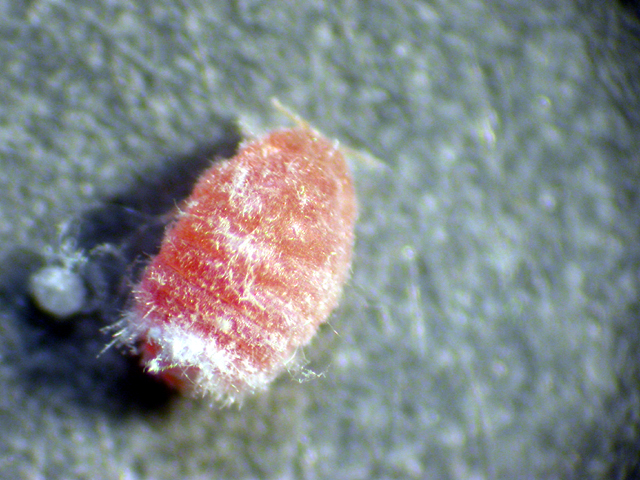
-
Banana Mealybug
Pseudococcus elisae Borchsenius. It has recently been found in the United States. This mealybug has been found infesting Aglaonema plants in Florida.
Characteristics for Jack Beardsley mealybug ( Pseudococcus jackbeardsleyi) which is present in Florida and looks very much like the Banana mealybug.
- No stripes on back
- Thin filaments present around the body
- Ovisac covering hind part of body
- Anal filaments about one-half length of body or more

